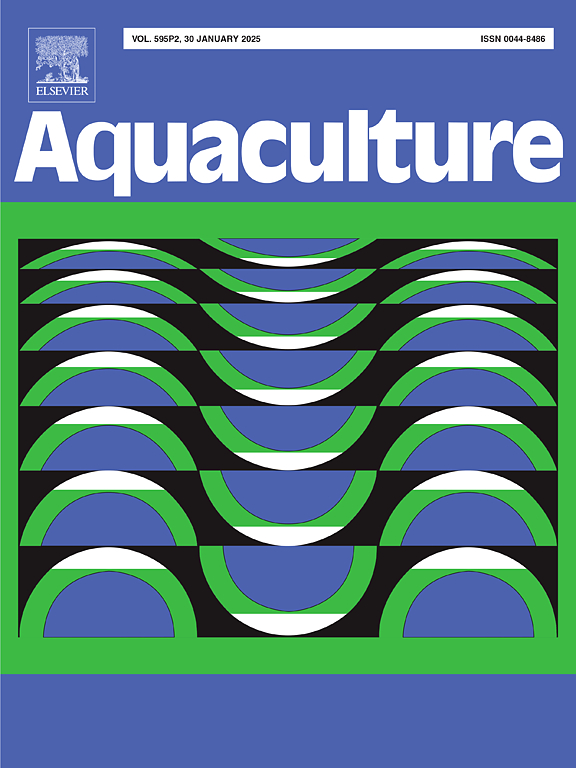Seawater adaptation of freshwater cultured rainbow trout (Oncorhynchus mykiss): Insights into the gut microbiota and tissue gene expression profiles
IF 3.9
1区 农林科学
Q1 FISHERIES
引用次数: 0
Abstract
Mariculture of rainbow trout (Oncorhynchus mykiss) represents a significant development in the field of freshwater aquaculture, due to the fact that, as a large anadromous fish, it can overcome the geographical restrictions on the culturing of this species, whilst also providing a higher quality food source for human consumption. In order to explore the seawater adaptation of rainbow trout, a salinity accumulation trial was performed with nine salinity point from freshwater (‰) to seawater (32 ‰). A total of 81 rainbow trouts were obtained with nine of each salinity point, and the changes in its gut microbiota and gene expression in diverse tissues (gill, intestine, kidney, and liver) were uncovered. The 16S-Seq revealed significant changes in the diversity and composition of the gut microbiota among rainbow trout under different salinity conditions. These changes were initially acute and subsequently stabilised over time. Following transfer to an seawater environment, the gut microbiota of rainbow trout established a stable state that was distinct from that of individuals inhabiting freshwater. The gut microbiota of rainbow trout inhabiting seawater exhibited a simple yet stable co-occurrence network, robust fermentation and cell structure biosynthesis, and drift-dominant assembly, characteristics that differ significantly from those observed in freshwater populations. The application of RNA-Seq to tissue cells has revealed higher sensitivity of liver and intestine compared of kidney and gill to salinity stress. Based on the differentially expressed genes in all four tissues, DNA damage, cancer risks, and rhythm disorders were observed in rainbow trout cultured in seawater. It is hypothesised that the heightened cancer risks observed in rainbow trout under conditions of elevated salt stress may be attributable to fluctuations in the composition of certain rare gut bacteria, such as Psychrobacter celer, Lactobacillus, and Escherichia. The results of the present study have revealed the response of the gut microbiota and host physiology of rainbow trout to salinity stress. This provides a solid foundation for the development of mariculture technology for this species.
淡水养殖虹鳟鱼(Oncorhynchus mykiss)的海水适应:肠道微生物群和组织基因表达谱的见解
虹鳟鱼(Oncorhynchus mykiss)的海水养殖代表了淡水水产养殖领域的重大发展,因为它作为一种大型溯河鱼类,可以克服该物种养殖的地理限制,同时也为人类消费提供了更高质量的食物来源。为探讨虹鳟鱼对海水的适应性,从淡水(‰)到海水(32‰)共9个盐度点进行了盐度积累试验。共获得81条虹鳟鱼,每个盐度点9条,揭示了其肠道微生物群和不同组织(鳃、肠、肾和肝)基因表达的变化。16S-Seq揭示了不同盐度条件下虹鳟鱼肠道微生物群的多样性和组成的显著变化。这些变化最初是急性的,随后随着时间的推移稳定下来。在转移到海水环境后,虹鳟鱼的肠道微生物群建立了一个与生活在淡水中的个体不同的稳定状态。生活在海水中的虹鳟鱼肠道微生物群表现出简单而稳定的共生网络、强大的发酵和细胞结构生物合成以及漂移优势组合,这些特征与淡水种群有显著不同。RNA-Seq技术在组织细胞中的应用表明,与肾脏和鳃相比,肝脏和肠道对盐胁迫的敏感性更高。根据这四种组织的差异表达基因,在海水养殖的虹鳟鱼中观察到DNA损伤、癌症风险和节律障碍。据推测,在高盐胁迫条件下虹鳟鱼中观察到的癌症风险增加可能是由于某些罕见肠道细菌组成的波动,如窖冷杆菌、乳杆菌和埃希氏菌。本研究结果揭示了虹鳟鱼肠道菌群和宿主生理对盐度胁迫的响应。这为该鱼种的海水养殖技术的发展提供了坚实的基础。
本文章由计算机程序翻译,如有差异,请以英文原文为准。
求助全文
约1分钟内获得全文
求助全文
来源期刊

Aquaculture
农林科学-海洋与淡水生物学
CiteScore
8.60
自引率
17.80%
发文量
1246
审稿时长
56 days
期刊介绍:
Aquaculture is an international journal for the exploration, improvement and management of all freshwater and marine food resources. It publishes novel and innovative research of world-wide interest on farming of aquatic organisms, which includes finfish, mollusks, crustaceans and aquatic plants for human consumption. Research on ornamentals is not a focus of the Journal. Aquaculture only publishes papers with a clear relevance to improving aquaculture practices or a potential application.
 求助内容:
求助内容: 应助结果提醒方式:
应助结果提醒方式:


